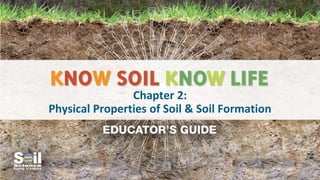
Educators PPT file chapter 2
- 1. Chapter 2: Physical Properties of Soil & Soil Formation
- 2. There are tens of thousands of soils in the world, and each is a bit different. Soils have identities: the characteristics are used to distinguish between different soils. Soil characteristics are important because they influence: • water movement into the soil (infiltration) • water movement within the soil (percolation) • water storage for plants • soil erosion • nutrient status & supply to plants • heat transfer • ease of tillage • root growth Why Soil Characteristics are Important soils4teachers.org/KSKL
- 3. Overview of Soil Image Credit: David Lindbo and Wale Adewunmi, Know Soil Know Life contributors Physical Properties of Soil • Color • Texture • Structure • Horizon/Profile Soil Formation – CLORPT Soil and Water soils4teachers.org/KSKL
- 4. Soil Color • Like M&M’S … soils have color! • Color is an indicator of certain chemical and physical characteristics. Image Credit: Adobe Stock; www.lovethispic.com/image/45129/tubes-of-m-ms soils4teachers.org/KSKL
- 5. Image Credit: Soil! Get the Inside Scoop, 2008, Soil Science Society of America Soil Color SPODOSOLS OXISOLS HISTOSOLS soils4teachers.org/KSKL soils4teachers.org/KSKL
- 6. Since color perception is subjective, soil color is determined using a standardized chart. Soil Color Image Credit: Wale Adewunmi, Know Soil Know Life contributor soils4teachers.org/KSKL soils4teachers.org/KSKL
- 7. • Every soil can be separated into 3 physical sizes based on the diameter of the particles. • Sand + Silt + Clay = Soil Texture Image Credit: SOIL! Get the Inside Scoop, D. Lindbo and others, ©2008 Soil Science Society of America; Adobe Stock Soil Texture soils4teachers.org/KSKL
- 8. • Is there an ideal soil? • Loam ≠ equal parts of sand, silt & clay Image Credit: Getty images; Everything You Need to Know About Soil, blog.primrose.co.uk Soil Texture soils4teachers.org/KSKL
- 9. Image Credit: SOIL! Get the Inside Scoop, D. Lindbo and others, ©2008 Soil Science Societies of America Soil Texture Triangle soils4teachers.org/KSKL
- 10. • Soil structure describes the arrangement of primary particles. • They are a naturally occurring arrangement. • A well-structured soil has an abundance of pores for water and air to move readily into the soil and to root systems. Soil Structure soils4teachers.org/KSKL
- 11. Granular Blocky Image Credit: Know Soil Know Life, D. Lindbo, D. Kozlowski, and C. Robinson - Editors, © 2012 Soil Structure soils4teachers.org/KSKL
- 12. Columnar or Prismatic Platy Image Credit: Know Soil Know Life, D. Lindbo, D. Kozlowski, and C. Robinson - Editors, © 2012 Soil Structure soils4teachers.org/KSKL
- 13. Single Grained Massive Image Credit: Know Soil Know Life, D. Lindbo, D. Kozlowski, and C. Robinson - Editors, © 2012 Soil Structure soils4teachers.org/KSKL
- 14. • Water flow through different soil structures • Which of these soil structures will allow water to move fastest through the soil? Image Credit: USDA-NRCS Effects of Soil Characteristics Granular Prismatic Subangular Blocky Platy soils4teachers.org/KSKL
- 15. Soil Profile Image Credit: SOIL! Get the Inside Scoop, D. Lindbo and others, ©2008 Soil Science Societies of America UTISOLS soils4teachers.org/KSKL
- 16. • Climate • Organisms • Relief • Parent Material • Time Soil Formation . . . or CLORPT! soils4teachers.org/KSKL
- 17. • Profile thickness • Horizon development • Organic Matter and thickness of A Horizon • Wetness • Color • Chemistry (pH, base saturation, salts) CLORPT Impacts soils4teachers.org/KSKL
- 18. Major Climatic Forces • Temperature • Precipitation Climatic conditions directly influence the weathering of materials in the soil. CLimate Image Credit: SOIL! Get the Inside Scoop, D. Lindbo and others, ©2008 Soil Science Societies of America soils4teachers.org/KSKL
- 19. Temperature • Plant growth • Biological activity • Decomposition • Mineralization • Evapotranspiration • Chemical reactions • A 10oC rise = 2-3x increase in reaction • Physical reactions • Freeze-thaw Precipitation • Plant growth • Biological activity • Decomposition • Mineralization • Dissolves materials • Translocations (leaching) • Transformation (chemical reaction) • Erosion Impact of Temperature and Precipitation soils4teachers.org/KSKL
- 20. Warm - Humid Warm - Dry Photo Credits: David Lindbo Climatic Differences soils4teachers.org/KSKL
- 21. • Plants • Grasses • Coniferous • Deciduous • Animals • Burrowing • Grazing • Micro- and Meso-organisms • Bacteria • Fungi • Worms, Insects Photos Credit: Adobe Stock Organisms soils4teachers.org/KSKL
- 22. Photo Credit: David Lindbo Examples of Biological Mixing or Bioturbation Rabbit Warrens Crayfish Burrows Ant Hills soils4teachers.org/KSKL
- 23. Also known as topography • Shape – hills/mountains vs flat/low-lying areas • Slope – steepness • Elevation – height above sea level • Aspect – direction a slope faces Relief Image Credit: SOIL! Get the Inside Scoop, D. Lindbo and others, ©2008 Soil Science Societies of America soils4teachers.org/KSKL
- 24. Slope Position Names Image Credit: SOIL! Get the Inside Scoop, D. Lindbo and others, ©2008 Soil Science Societies of America soils4teachers.org/KSKL
- 25. • Organic materials • Bedrock • Transported materials Parent Material Image Credit: SOIL! Get the Inside Scoop, D. Lindbo and others, ©2008 Soil Science Societies of America soils4teachers.org/KSKL
- 26. Parent Material - Transported Materials Image Credit: Know Soil Know Life, D. Lindbo, D. Kozlowski, and C. Robinson - Editors, © 2012 soils4teachers.org/KSKL
- 27. How many years does it take to form an inch of soil? Time Image Credit: SOIL! Get the Inside Scoop, D. Lindbo and others, ©2008 Soil Science Societies of America soils4teachers.org/KSKL
- 28. TIME IN SOIL FORMATION IS ALSO RELATIVE Degree of Development Hot - Dry Desert SLOW Cold - Dry Antartica SLOW Hot - Wet Tropics FAST Cold - Wet Northern Canada SLOW soils4teachers.org/KSKL
- 29. YOUNG few horizons OLDER more horizons Photo Credit: David Lindbo Time Differences soils4teachers.org/KSKL
- 30. General Time Sequence Image Credit: Webinar, Soils: Fundamental to Life, ©2018 Soil Science Societies of America soils4teachers.org/KSKL
- 31. Image Credit: NRCS Kentucky Soil & Water - The Water Cycle soils4teachers.org/KSKL